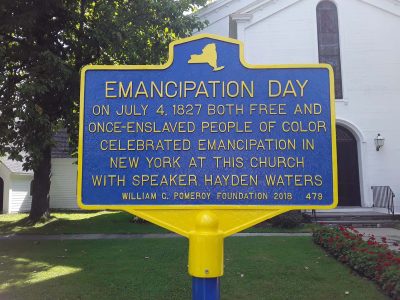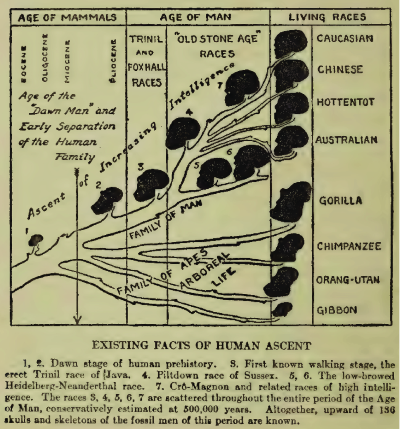
Juneteenth and 1619 have been in the news a lot lately. What both dates have in common is that neither one directly affected New York. Neither New York nor New Amsterdam even existed in 1619. The famous purchase of the land from the Lenape did not occur until 1624. Slavery began in 1626. Similarly at the other end, by the time of June 19, 1865 in Texas, emancipation was a 38-year-old experience in New York. July 4, 1827, is the date of significance for New York with the celebration occurring the next day. That was the day of a big parade in New York City, near where the African-American burial ground is today.
The 38 years between emancipation here and emancipation in Texas should not be forgotten. In a speech entitled “The Meaning of the Fourth of July for the Negro,” Frederick Douglass famously asked, “What, to the American slave, is your 4th of July?” In 1852 when he asked that question, it had been rendered moot in New York. He might have asked what to the emancipated slave in New York was July 4th. So let us examine what the Negroes of the speech had been doing as free people in New York.
Take for example the life of Solomon Northup. For 12 years he was a slave as the book and movie tell. That means for most of life his was not, he was a free person. One glimpses that life at the beginning and ending of the movie about him. However, the story of his life as a free person is not told.
Take for another example the big three in New York for the Underground Railroad: Douglass, Sojourner Truth, and Harriet Tubman. It is easy to imagine a student wondering how these people could travel freely about the State giving speeches and writing articles before 1865, the nationally-celebrated day of independence. Will teachers explain to the students that by 1865, emancipation already had occurred here 38 years earlier? Will that be in the curriculum?
The questions we can ask of these lives are the ones we ask of any people:
Where did they live?
Where did they pray?
What did they do?
Where were they buried?
Where were their schools?
What were their newspapers?
Where did they play baseball?
Some of these questions are better answered after 1865 than beforehand.
As free people, they no longer were restricted to the attics, crawlspaces, and basements of their former owner’s home. Instead they were free to create their own communities. These places may no longer exist such as the integrated Seneca Village in what became Central Park or the Hills in north White Plains/Harrison. Some live on as historical sites like Weeksville in what is now Brooklyn. Sometimes only a building survives like the Myers House in Albany.
Weeksville remembers 1827. It commemorated it this year.
Freedom is forever! Commemorate the 5th of July and our victory in the struggle for self-determination and liberation.
In 1827, Black New Yorkers began to observe the 5th of July as a way to safely celebrate their recent emancipation while quietly critiquing America’s Independence Day. This celebration is annually acknowledged at Weeksville Heritage Center and became the namesake of our 5th of July Resource Center for Self-Determination & Freedom.
The Gerrit Smith Estate National Historic Landmark in Peterboro remembers the emancipation.
The Gerrit Smith Estate was the lifetime home and office of Gerrit Smith (1797-1874). Driven by his liberal ideas and empowered by his wealth, he was one of the most powerful abolitionists in the United States. Scores of abolitionists received support and renewed commitment to the cause of freedom at Smith’s home in Peterboro.
Smith helped hundreds of African Americans by purchasing their freedom from slavery, arranging safe passage to Canada, helping families establish their lives locally, gifting land, providing educational opportunities, and working for human rights. Due to Smith’s persuasive and exemplary efforts, Peterboro became a crossroads for human benevolence.
Today, this historic location has become mostly forgotten. The name Gerrit Smith has little recognition. But this man and this place have earned their place in the history books.
One action in particular links him to John Brown of Harpers Ferry fame. In 1846, Smith divided 120,000 acres of untouched land that he owned in the Adirondacks into 40-acre plots and began granting them to three thousand free African Americans living in New York State. To secure the right to vote, settlers would have to cultivate the land to improve its value, but Smith believed this was feasible.
The settlement was located in North Elba, and was referred to as “Timbuctoo” (or Timbucto) by abolitionist John Brown. Brown himself purchased land near the settlement and made it his mission to help settlers adjust to a new way of life and learn the skills they would need to survive on the land. That land is now the John Brown Farm State Historic Site.
I mention these snippets to show from Brooklyn to the Adirondacks and west, there were people, places, and events to be remembered in the time between 1827 and Juneteenth.
In Westchester where I live, the African American Heritage Trail consists of only a few sites from the pre-Juneteenth period of emancipation:
African Cemetery (1860) – Rye
Foster Memorial AME Zion Church (1860) – Tarrytown
Stony Hill Cemetery – Harrison
Should there be more sites? Are there sufficient history markers? Are they part of the school curriculum? Are there field trips? Do tourists know about them?
New York State is aware of the historic significance of July 4, 1827. In 2020, the Governor signed a bill that “Designates the second Monday in July each year as a day of commemoration, to be known as Abolition Commemoration day”:
The commemoration day will solemnly remember the abolishment of slavery in New York State on July 4, 1827 and honor the bravery and sacrifices of abolitionists of the state; those known and those whose names will never be known.
July 12, 2021, will be the first Abolition Commemoration Day since the bill was signed into law. What are you doing today in recognition of this day in New York History?
I first began blogging about 1827 in 2016. Eventually, I approached Shelly Mayer, my State Senator, to propose that a Bicentennial Commission be created at the state level for this event. Working with her staff, we created a bill by February 2020 that was ready to be proposed in the upcoming legislative session. Then COVID hit. Then Tulsa. Then Juneteenth. Then Senator Mayer co-sponsored the American Revolution 250th Commission bill which just passed. After speaking with her at a recent Juneteenth event, I am hopeful that in the 2022 legislative session, a bill to authorize a Bicentennial Commission for Abolition Day will be introduced, passed, and signed. Maybe then as many New Yorkers will remember what happened in the state where they live as they do events in Virginia and Texas where they do not live.





Did they Celebrate on July 4?
Most Black communities in New York State celebrated their freedom on July 5: it was called The Fifth of July they, not wanting to celebrate on what was until then a white festival.
Carol
The legal date was July 4 but the decision to celebrate on July 5 instead was a wise one. You are correct.
Thank you Peter for this important memory of our history in New York. The history belongs to everyone and the more we know the more we find our common thread.
Renee Moore. solomonnorthupday.org.